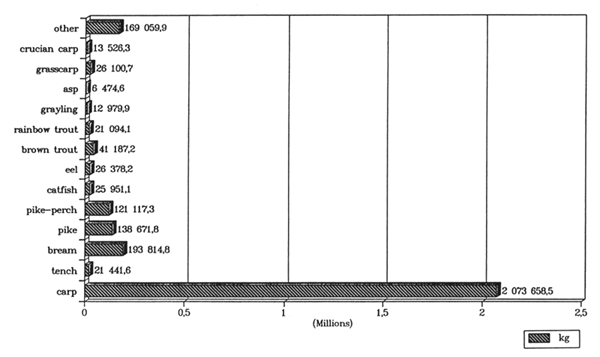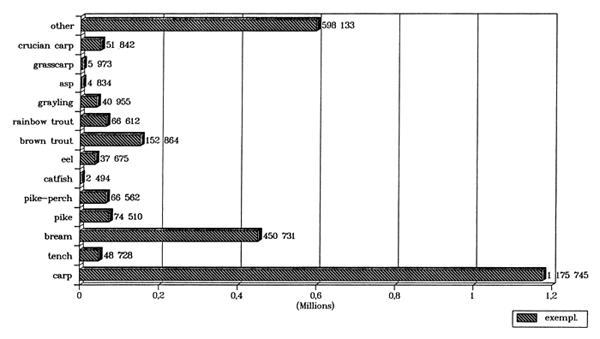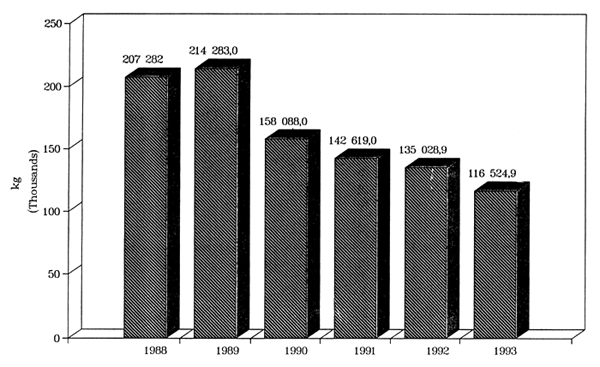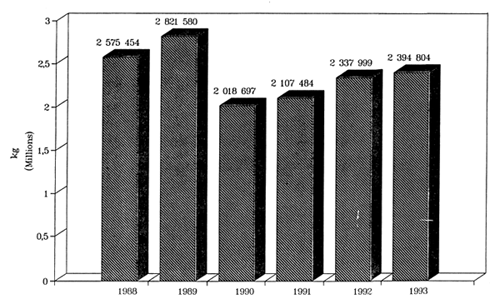J. VOSTRADOVSKÝ AND J. MRÁčEK
Fisheries Research Institute, Jivenska 3, 14100 Praha 4, Czech Republic
Sports angling has a long tradition in the Czech Republic. This has to no small extent been due to traditional fish breeding in ponds and lakes, and to a rich network of rivers in the Republic's territory. The Czech Republic is situated at the watershed of three seas, namely the North Sea, (the Elbe), the Black Sea (the River Morava as a tributary of the Danube), and the Baltic Sea (the River Oder). The Morava and the Elbe leave the Czech Republic's territory at an a.s.l. of between 113 m and 115 m, with the majority of waters situated between that and 1 000 m a.s.l. Up to the beginning of this century, due to the purity of the rivers, there were 35 indigenous fish species, 18 fish species from outside the Czech territory, and 14 acclimatized species (rainbow trout, brook trout, Danubian salmon, whitefish maraena and peled, grass carp, stone moroco, goldfish, silver carp, bighead, brown bullhead, largemouth bass, common sunfish, stickleback). Some fish species, both original and migratory ones, had to be included in the list of endangered species, and some may be definitely lost to many rivers (due to dam constructions, impaired migration, etc.). Waters used mostly for sports angling are cared for mainly by the Czech Anglers' Union (český rybářský svaz - čRS), an organization dealing not only with sports angling but also with the protection of fish and their living environment, the education of members (including youth), and breeding and stocking of fish, etc. The data given below have been acquired from the results of čRS activities. In addition, in the South Moravian region, where the Moravian Anglers' Union (Moravský rybářský svaz - MRS) has been working independently (since 1991), individual pond and lake owners have developed similar activities in certain localities. čRS manages fish breeding and carries out angling in the river basins of the Elbe (51 393.6 km2), the Oder (over 10 000 km2), and a part of the Morava Basin (26 579.7 km2).
Hydrological conditions
In the Czech Republic, rivers have full water capacity in the period of springtime snow thaw. In the lowlands it is usually in February and March, in the highlands in March, and in the mountain regions as late as May. The lowest flows occur in the period from August through the winter months. Natural lakes are few in the Czech Republic (1 000 – 1 100 m a.s.l. in the Šumava mountain range), mostly with low pH and without fish, and covered with ice from December to April and even May. Efforts aimed at keeping water stocked within the Czech Republic's territory resulted in lake and pond building in the past (14th and 15th centuries) of which 21 000 remain to date, covering a total of 49 000 ha. The area of built-up reservoirs extends over 25 000 ha. A major part of this is used for the purpose of sports angling by the Czech Anglers' Union (60%), the Moravian Anglers' Union (20%), and Water Authority enterprises which, however, do not carry out organized sports angling (reservoirs with drinking water).
Sports angling practice
Within the Czech Republic's territory, sports angling is governed by the Law on Fisheries No. 102/1963 and Order No. 103/1963. Trout angling is practised in trout as well as non-salmonid waters (brooks, rivers, riverside branches, water-filled sand- and stone-pits, reservoirs) by 450 local angling organizations (clubs) associated with the Czech Anglers' Union. The Union has 227 000 members (171 000 men, 4 000 women, 15 000 juniors, 37 000 children). The Union has a total of 31 512 ha (28 000 ha non-salmonid waters and 3 500 ha trout waters). Along with the obligation to own a State Fishing Licence (a fee has to be paid to the State) a Union member has the right to purchase local, regional and whole Union permits for angling in non-salmonid and/or trout waters. A permit may be valid for one year or even for a shorter time period. There is a 10:1 ratio of the number of angling permits issued annually for non-salmonid and trout waters. Receipts from sales of both types of permit to Union members amount to around US$ 1.2 million.
Each member has not only the right to fish, but at the same time must also keep certain obligations such as observing angling regulations (protecting the fish and angler in accordance with the Law and regulations), participate in Union activities (member meetings, schooling, work for the maintenance of fish-breeding facilities for a certain number of hours (or payment for this), and present, within a time limit, the catch report for statistical processing). At present a new draft Law on Fisheries is under preparation that will encompass also changes in ownership and new economic relations which took place after 1989 and after the division of former Czechoslovakia.
Regulations for sports angling and records
Every catch angler is obliged to observe the Anglers' Board which includes various provisions such as:
Conservation period of individual fish species
| 1 January | - | 15 June | pike, pike-perch, asp, wels |
| 1 December | - | 15 April | rainbow trout |
| 1 December | - | 15 June | grayling |
| 1 January | - | 30 September | Danubian salmon (hucho) |
| 1 November | - | 31 January | burbot |
In rivers no angling takes place from 16 March to 15 June (in reservoirs to 30 April). Twenty-two fish species have minimum legal size (total length of the fish), e.g. carp - 35 cm, tench - 20 cm, pike - 50 cm, pike-perch - 40 cm, wels - 90 cm, grass carp - 60 cm, brown trout - 25 cm, rainbow trout - 23 cm, etc. There exist local changes that are mentioned in Local Anglers' Boards (each angler gets one while purchasing a permit).
All-year conservation applies to all crayfish species and to 16 fish species (e.g. minnow, sculpins, mud loach, spirlin, loach, and others).
Angling in non-salmonid waters is practised with two rods only, angling with towed artificial bait (and in trout waters) with one rod only.
Also, day angling time is set down with limitation according to the season of the year. During the calendar year it varies between 3 a.m. up to 11 p.m.
While purchasing a fishing permit the angler at the same time receives a statistical catch report (printed form) where he writes down each fish that he retains (species and weight). After the termination of the fishing permit he conveys the form along with the statistical report. Failure to fulfill this obligation results in losing the possibility of obtaining a fishing permit for the following year.
Permitted number of fish caught (taken into possession) varies in trout and non-salmonid waters. In trout waters daily catch allows for 4 pieces of salmonid fish for three days a week. In non-salmonid waters an angler may retain 7 kg fish (however, this may include two pieces of carp, pike, pike-perch, wels, asp, grass carp), and he finishes angling when he catches even one fish only which is heavier than 7 kg (if he retains it). If he reaches the annual catch limit (100 pieces of salmonid fish in trout waters), he can purchase a new fishing permit. Since 1993, this provision has been cancelled.
Prescribed kit parts also are hand net, deposit net and forceps.
Water quality
In general, the cleanliness of water in the rivers is improving. This is a result of more intensive construction of sewage disposal plants and generally more intensive care given to ecology. However, this was mainly contributed to by a reduction in production volume of some less effective industrial plants and by the limitation of use of agricultural chemicals. A number of river fish species (barb, vimba bream, ide) returned to formerly heavily polluted rivers (the Elbe, the Lower Vltava (Moldau) below Prague), and the total number of all fish increased.
The number of recorded accidents resulting in perished fish marked even a sevenfold decline (234 accidents in 1975, 36 in 1994). At present, still about 1 000 km rivers (900 ha) are polluted and are subject to permanent controls by veterinary and hygienic services. Consumption of fish is prohibited in several localities. The most frequent cause of accidents is leakage of oil and oil products.
Present situation with lchthyocenosis
Ichthyocenoses in free waters (rivers and reservoirs) usually constitute a value of 100 – 500 kg.ha-1 biomass. In single cases this value may be twice or three times as high. In non-salmonid waters the most numerous fish species are roach and bream, bleak and white bream. These carp species of fish (family: Cyprinidae) usually constitute 40–90% of all present fish species.
In trout streams the biomass of salmonid fish varies from 20 (mountain streams) up to 400 kg.ha-1 (lowlands trout streams). In certain rivers (the Vltava-Moldau, the Ohře-Eger) secondary trout zones came to life below dams stocked by large brown trout and rainbow trout (Put and Take system). The fish situation is improving rapidly in the Elbe, the Vltava-Moldau below Prague, the Morava river below Olomouc and elsewhere due to water quality improvement. In 1994, mass migration of small eels through the Elbe from Germany to Czech territory was observed.
Abundance of predatory fish stock in rivers and reservoirs is low where it usually does not exceed 1–3 %. Renewed occurrence of species valued by sports anglers (carp, predators, riverine fish species) is attained by putting in fish fry and fingerlings and stockfish. The salmonid fish capacity is being maintained entirely through artificial stocking.
Stocking
The proper production of fingerlings and stockfish for the purpose of stocking angling waters belongs to the main Czech Anglers' Union activities. To produce stocking material, the Union has about 2 500 ha lakes and tens of smaller or larger hatcheries. The main fish to be caught and also produced (as stock material) is carp. In spite of this, production is not sufficient and additional material has to be bought from other producers. The following fish species are used for fry, fingerlings and stockfish breeding.
| Salmonid Fish | Coarse Fish | Predatory Fish |
| brown trout (age 2 years) | carp (age 2–3 years) | pike (age 1 year) |
| rainbow trout (age 2 years) | tench (age 2 years) | pike-perch (age 1 |
| grayling (age 1 year) | barb (age 0.5–1 year) | wels (age 0.5–1 year) |
| brook trout (age 1–2 years) | nase (age 1 year) | |
| burbot (age 0.5–1 year) |
Grass carp (age 1–2 years), and white fish (fry) etc. are also used.
All free waters are being stocked following the requirements specified (species, sizes, quantities) in a plan which is approved by the Ministry of Agriculture. The plan for fish stocking is usually exceeded in carp and brown trout fingerlings and stockfish. The sphere of interest (supported by contributions from the Ministry of Agriculture) includes also fish species that are waning in consequence of the negative impact of adverse civilization factors (burbot, barb, base, ide), or that are belonging to protected and non-angled fish species (minnow, spined loach, stone loach). Every year glass eels are imported to the Czech Republic by air (389 kg, i.e. 1.3 million pieces, in 1994). In general, about 25 fish species are stocked, of which the greater part comes from artificial breeding (hatcheries).
In 1994, 1 757 t (9.5 million pieces) of all fish were stocked into angling water districts. Among those most represented are carp (1 500 t, 2.1 million pieces), brown trout (14.1 t, 1.8 million pieces), pike, pike-perch, rainbow trout (27.3 t, 358 000 pieces), grass carp (13.4 t, 116 000 pieces), etc.
Fish catch by angling and stocking returns
Members of the Czech Anglers' Union catch fish for sports reasons. However, due to the tradition of consuming freshwater fish a part of the anglers retain and consume the catch. The subject of greatest interest is the catch of carp, bream and predatory fish species (pike, pike-perch, wels), and from among salmonid fish, brown trout, rainbow trout and grayling. The amount of annual catch is obtained by the total number of catches by individual anglers (total catch in 1994 is given in Figs. 1 and 2). Carp constitutes 50–75% of all-year catch of all fish (i.e. 2–3 000 tons). The rest belong to the other fish species. In 1994, over 2 000 t carp (1.2 million pieces), 200 000 kg bream (0.4 million pieces), and approximately the same amount of pike and pike-perch were caught. In trout waters, the 1994 catch was 38 t brown trout (145 000 pieces), and 17 t rainbow trout (55 000 pieces), etc. Total catches in trout and non-salmonid waters during 1988–1993 are given in Figs. 3 and 4.
In the last 10–20 years the annual fish catch reached approximately the same level in spite of the fact that the number of anglers increased in that period. The catch volume is always determined by the volume of previously stocked fish. In particular, this can be observed with carp, where the size of fish stocked is also an important factor. The returns increase with the growing size of stocking material, which of course makes the economy of the whole undertaking more expensive. The same also applies in the case of brown trout and rainbow trout stocking material.
In the last 10 years the catch from 1 ha of water area varied in carp from between 38.5 – 82.6 kg.ha-1, in pike between 5.9–10.1 kg.ha-1, in pike-perch between 2.7–5.5 kg.ha-1, in bream between 6.8–10.4 kg.ha-1. The total fish catch from an area of 1 ha reached by anglers was usually between 66.0–100.3 kg.ha-1. The largest yields (carp, predators) i.e. catch in kg.ha-1, were reached in smaller water areas, while a smaller catch was reached in larger areas of reservoirs (with areas of up to several thousand hectares), as in the following table:
Table 1 Examples of Yields in Selected Reservoirs
| Reservoir Lipno | Reservoir Orlik | Reservoir Nechranice | Reservoir Jordán |
| 4 650 ha | 2 600 ha | 1 000 ha | 50 ha |
| Carp catch (kg.ha-1) | |||
| 9.7 | 16.4 | 42.6 | 140.5 |
| Pike perch (kg.ha-1) | |||
| 5.6 | 7.3 | 2.3 | 90 |
| Total fish catch (kg.ha-1) | |||
| 20.4 | 50.3 | 61.7 | 171.2 |
The most favourite fish caught and stocked is carp. It is stocked at a weight of 0.5–0.75 kg per piece. The carp returns per piece are approximately 50%. Regarding the weight, it was 192.7 – 160.1%.
Social and economic aspects of angling
Under the present conditions that have changed both politically and economically, the subject of interest of the čRS organizations is to maintain the availability of sports angling to the widest possible strata of the Czech Republic population. This should be facilitated through reasonable prices for fishing permits and through the maintenance of good stocking of free waters, even despite the sometimes high price of fish on the market, etc. The aim is to preserve the catch volume and ensure the protection of fish quantity and quality. Anglers are cooperating in the preparation of the new Law on Fisheries. They are still of the opinion that free waters (rivers, reservoirs) should remain under State ownership for leasing to anglers' organizations to guarantee compliance with all requirements (protection, stocking, as well as angling organization) in the most efficient and economical way.
Anglers, by producing a large quantity of stocking material and carrying on various protective measures by themselves, make the entire operation considerably cheaper and reduce the price of permits to an acceptable level. The significant and economic contributions of sports angling, not only from a commercial aspect, are evident also by the fact that sports angling as a subject is taught both at the Secondary Fishing School in Vodňany and at the Apprenticeship School in Třeboň as well as at Agriculture Universities where fishing experts are being educated.
The Czech Anglers' Union has also got its own sports league. Every year competitions in individual disciplines are held and the winners participate in international competitions. One of the recent successes has been the award of the title of World Champions in Fly Angling.

Fig. 1 Total catch (kg) in 1994

Fig. 2 Total catch (pieces) in 1994

Fig. 3 Total catch in trout waters (1988–1993)

Fig. 4 Total catch in non-salmonid waters (1988–1993)